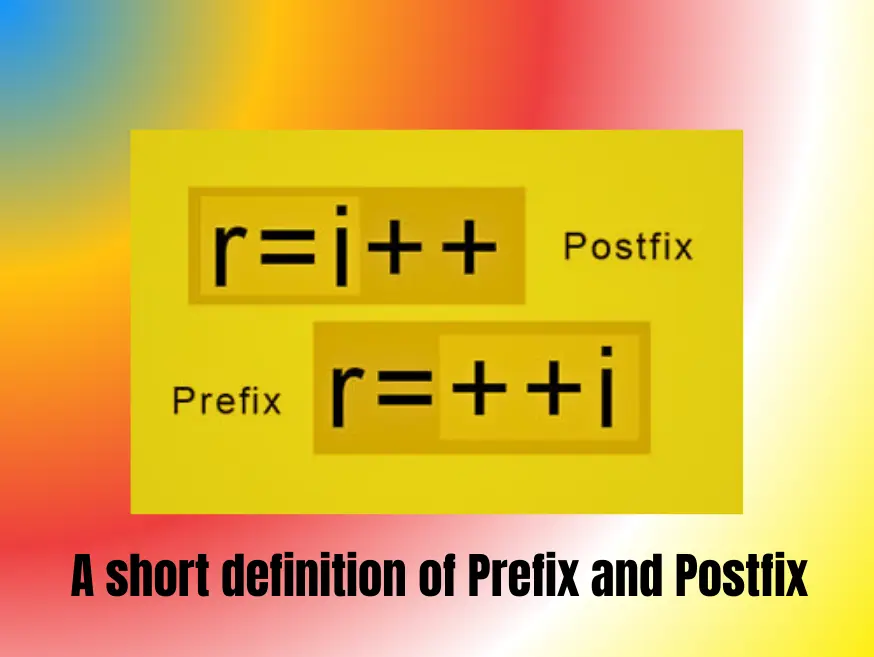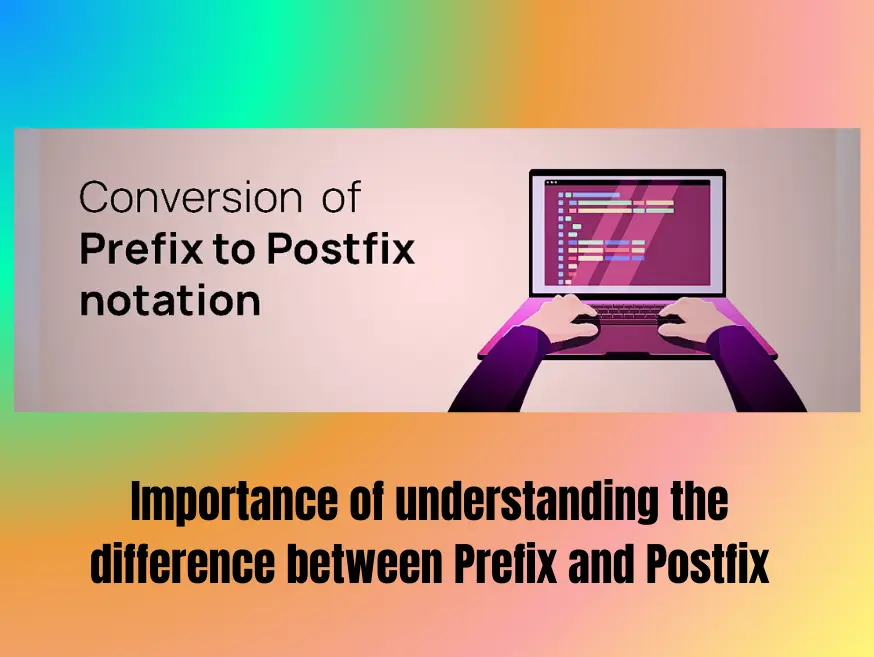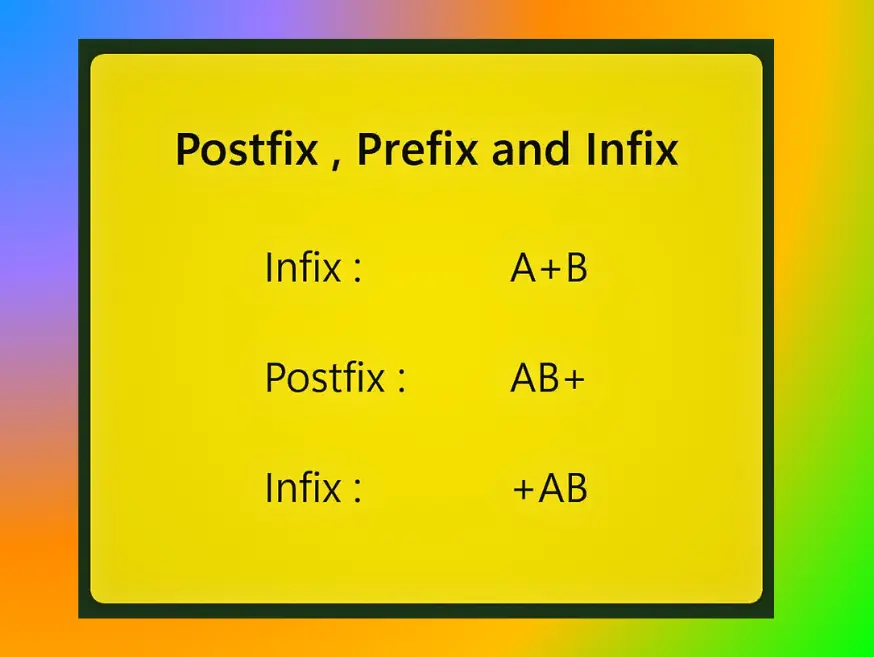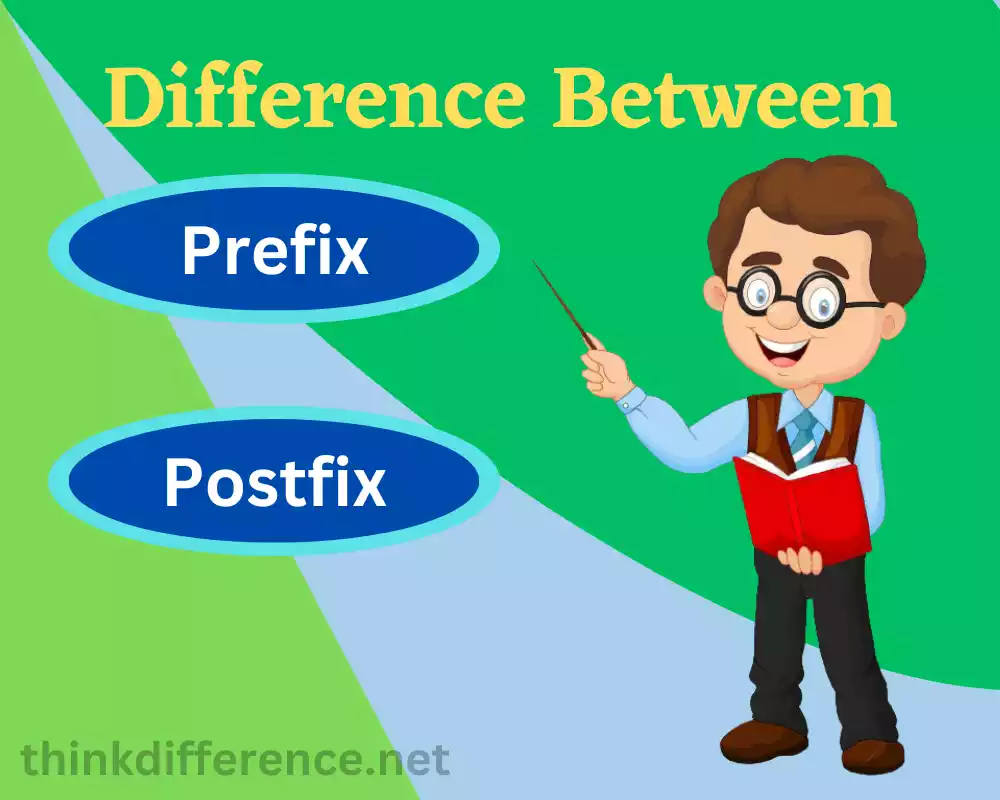Prefix and postfix notations are alternative ways of representing mathematical and logical expressions. They both aim to eliminate the need for parentheses to denote precedence in an expression. While traditional infix notation places operators between operands, prefix and postfix notations position operators before or after operands, respectively. This alteration in syntax offers a unique perspective on expression evaluation.
A short definition of Prefix and Postfix

Prefix: A prefix is a linguistic element added to the beginning of a word or a root to modify its meaning. In the context of computer science and programming, a prefix refers to a notation or expression in which the operator is placed before its operands. It is also known as prefix notation or Polish notation.
Prefix notation involves operators being followed by operands and evaluated based upon both their actions as well as values associated with these operands. This notation is commonly used in mathematical expressions, programming languages and computer algorithms.
Postfix: Postfix, also known as postfix notation or reverse Polish notation (RPN), is a notation or expression in which the operator is placed after its operands. Postfix notation lists both operands and operators before proceeding to list each operand individually. The expression is evaluated by performing the specified operation on the operands in the order they appear.
Parentheses no longer need to indicate how operations are performed since an operator’s position will dictate which task needs to be undertaken. Postfix notation is commonly used in mathematical expressions, calculators, stack-based programming languages and some computer architectures. It offers a more concise and unambiguous representation of mathematical expressions compared to infix notation.
Importance of understanding the difference between Prefix and Postfix

Realizing the differences between postfix and prefix notations are critical for various purposes. Knowing when one should apply which form may prove essential in making decisions quickly.
- Expression Evaluation: Prefix and postfix notations have different evaluation rules and processes. Knowing how to interpret and evaluate expressions in both notations allows for efficient computation and accurate results. This knowledge is particularly valuable in programming and mathematical calculations.
- Programming Languages: Many programming languages support both prefix and postfix notations for expressing mathematical and logical operations. Being able to distinguish between the two and choose the appropriate notation can enhance code readability and maintainability. Developers can take full advantage of programming languages and their syntax by harnessing all its power.
- Algorithm Design: Certain algorithms and data structures, such as expression parsing, abstract syntax trees, and stack-based evaluations, rely on prefix or postfix notations. Understanding the differences between the notations helps in designing and implementing these algorithms correctly and efficiently.
- Expression Conversion: Knowledge of prefix and postfix notations allows for the conversion between the two. This can be useful when working with existing code or when expressing mathematical formulas in a specific notation required by a system or tool. Conversion between notations can also help in simplifying or optimizing expressions.
- Flexibility and Adaptability: Different scenarios and applications may call for the use of prefix or postfix notation based on factors such as readability, performance or compatibility. Having a solid understanding of both notations allows for flexibility in choosing the appropriate notation for a given situation.
Understanding the difference between prefix and postfix notations is crucial for accurate expression evaluation, efficient programming, algorithm design, expression conversion and overall flexibility in various computational tasks.
Prefix Notation
Prefix notation is a mathematical notation in which operators are placed prior to their operands. One or more operators then follow with one of their operands to form expressions. The entire expression is evaluated by applying the operator’s operation to the operands.
For example, let’s consider the infix expression “2 + 3”. In prefix notation, it would be expressed as “+ 2 3”. Here, the “+” operator is placed before the operands 2 and 3.
Prefix notation eliminates the need for parentheses to indicate the order of operations. It provides a concise representation of mathematical expressions and simplifies the parsing process. It is particularly useful in programming languages, where it allows for unambiguous expression evaluation.
To evaluate a prefix expression, the following steps are typically followed:
- Read the expression from right to left.
- When encountering an operator, perform the specified operation on the next operands.
- Replace the operator and operands with the result.
- Repeat steps 2 and 3 until the entire expression is evaluated, resulting in a single value.
For example, let’s evaluate the prefix expression “+ 2 3”:
- The “+” operator is encountered. The next two operands are 2 and 3.
- Perform the addition operation: 2 + 3 = 5.
- Replace “+ 2 3” with “5”.
- The final result of the prefix expression “+ 2 3” is 5.
Prefix notation is commonly used in programming languages like Lisp, Scheme and Forth. It allows for straightforward parsing and evaluation of expressions and can be beneficial in mathematical calculations, algorithm design and building mathematical parsers.
Postfix Notation
Postfix notation, also known as postfix notation or reverse Polish notation (RPN) is a mathematical notation in which operators are placed after their operands. First listed here are the operands and then their operators.
For example, let’s consider the infix expression “2 + 3”. In postfix notation, it would be expressed as “2 3 +”. Here, the operands 2 and 3 are listed before the “+” operator.
Postfix notation eliminates the need for parentheses to indicate the order of operations. It provides a concise and unambiguous representation of mathematical expressions, making it easier to evaluate.
To evaluate a postfix expression, the following steps are typically followed:
- Read the expression from left to right.
- When encountering an operand, push it onto a stack.
- When encountering an operator, pop the required number of operands from the stack.
- Perform the specified operation on the operands.
- Push the result back onto the stack.
- Repeat steps 2-5 until the entire expression is evaluated.
- The final result will be the top element of the stack.
For example, let’s evaluate the postfix expression “2 3 +”:
- The operands 2 and 3 are encountered and pushed onto the stack.
- The “+” operator is encountered. Pop 2 and 3 from the stack.
- Perform the addition operation: 2 + 3 = 5.
- Push the result (5) back onto the stack.
The final result of the postfix expression “2 3 +” is 5.
Postfix notation is commonly used in calculators and stack-based programming languages like Forth. It simplifies expression evaluation and eliminates the need for explicit parentheses or precedence rules. It is particularly useful in implementing mathematical expressions, parsing algorithms and evaluating complex formulas.
Comparison Between Prefix and Postfix
When comparing prefix and postfix notations, there are several key differences to consider. Here is a comparison between prefix and postfix notations:
1. Syntax:
- Prefix: The operator is placed before the operands. For example, “+ 2 3”.
- Postfix: The operator is placed after the operands. For example, “2 3 +”.
2. Evaluation Process:
- Prefix: The expression is evaluated by reading from right to left. When encountering an operator, the operation is performed on the next operands.
- Postfix: The expression is evaluated by reading from left to right. When encountering an operator, the required operands are popped from the stack and the operation is performed on them.
3. Order of Operations:
- Prefix: Operators are evaluated strictly from right to left.
- Postfix: Operators are evaluated strictly from left to right.
4. Parentheses:
- Prefix: Parentheses are unnecessary as operation order depends on where an operator stands in relation to other operators and elements in his/her surroundings.
- Postfix: No parentheses necessary as its notation outlines precisely when each step occurs in sequence.
5. Readability and Understanding:
- Prefix: Initially, Prefix notation can be difficult for those unfamiliar with it to comprehend and read, especially at first.
- Postfix: Postfix’s notation tends to appear more natural as its operands appear before its operator for easier reading and comprehension.
6. Conversion:
- Prefix: Converting an expression from infix notation to prefix notation can involve rearranging the operators and operands.
- Postfix: Converting an expression from infix notation to postfix notation can be done by maintaining the order of operators and operands while removing the parentheses.
7. Applications:
- Prefix: Prefix notation is commonly used in programming languages like Lisp and Scheme. It is also used in some mathematical algorithms and expression parsing.
- Postfix: Postfix notation is frequently used in calculators, stack-based programming languages like Forth and some computer architectures.
Both postfix and prefix notations offer different advantages, depending on factors like programming language requirements or app usability/ease-of-use/personal preferences. When making this choice it’s essential to bear this in mind.
Choosing Between Prefix and Postfix
Before selecting either postfix or prefix designations, it is crucial that numerous considerations be taken into account. Below are a few aspects you must keep in mind to make an appropriate choice:
Programming Language or Environment:
- Some programming languages or environments may have a preference for one notation over the other. Consideration must be given to the cultural or language guidelines and conventions in which your workplace operates.
Readability and Understanding:
- Consider the readability and understandability of the notation. Postfix notation is often considered more intuitive and easier to read, as the operands come before the operator. This may vary depending on the familiarity of the individuals reading or maintaining the code.
Conversion Requirements:
- Evaluate whether there is a need to convert expressions between prefix and postfix notations. If there are specific requirements or tools in place that necessitate converting expressions, it may be more convenient to choose the notation that allows for easier conversion.
Operator Precedence and Clarity:
- Consider the complexity and clarity of expressions when using either notation. In some cases, prefix notation may require explicit parentheses to indicate the desired order of operations, especially when dealing with expressions involving multiple operators and operands.
Performance Considerations:
- Evaluate any performance considerations associated with the chosen notation. Although the impact may be minimal in most cases, some specific algorithms or computational tasks may benefit from the efficiency of one notation over the other.
Familiarity and Expertise:
- Consider your familiarity and expertise with both notations. If you or your team members are more comfortable and experienced with one notation, it may be more efficient and practical to use that notation for consistency and ease of development.
Compatibility and Integration:
- Evaluate the compatibility and integration requirements of the notation within the broader context of your project or system. Ensure that the chosen notation aligns well with other components and tools being used.
The choice between prefix and postfix notations depends on the specific requirements of the project, the programming language or environment, the readability and understanding of the code and any conversion or performance considerations. Consider these elements and make an educated choice that meets both your requirements and limitations in making an intelligent choice for yourself and/or your organization.
Commonly Used Prefix and Postfix Operations

Commonly used operations in prefix and postfix notations include arithmetic operations, logical operations and mathematical functions. Here are some examples of commonly used operations in both notations:
Prefix Notation Examples:
1. Arithmetic Operations:
- Addition: + 2 3
- Subtraction: – 5 2
- Multiplication: * 4 3
- Division: / 6 2
2. Logical Operations:
- Logical AND: AND TRUE FALSE
- Logical OR: OR TRUE FALSE
- Logical NOT: NOT TRUE
3. Mathematical Functions:
- Square root: SQRT 9
- Exponentiation: POW 2 3
- Absolute value: ABS -5
Postfix Notation Examples:
1. Arithmetic Operations:
- Addition: 2 3 +
- Subtraction: 5 2 –
- Multiplication: 4 3 *
- Division: 6 2 /
2. Logical Operations:
- Logical AND: TRUE FALSE AND
- Logical OR: TRUE FALSE OR
- Logical NOT: TRUE NOT
3. Mathematical Functions:
- Square root: 9 SQRT
- Exponentiation: 2 3 POW
- Absolute value: -5 ABS
Be mindful that these examples only demonstrate basic operations. Both prefix and postfix justifications support an array of mathematical and logical functions, depending on which language or environment the code was written for and any additional extensions or libraries added later.
Implementing Prefix and Postfix Notation
Implementing prefix and postfix notation involves developing algorithms or functions that can parse and evaluate expressions in these notations. Here are some steps you can follow to implement prefix and postfix notation:
Implementing Prefix Notation:
- Read the prefix expression from right to left.
- If the current element is an operand, push it onto a stack.
- If the current element is an operator, pop the required number of operands from the stack.
- Perform the operation on the operands.
- Push the result back onto the stack.
- Repeat steps 2-5 until the entire expression is evaluated.
- The final result will be the top element of the stack.
Implementing Postfix Notation:
- Read the postfix expression from left to right.
- If the current element is an operand, push it onto a stack.
- If the current element is an operator, pop the required number of operands from the stack.
- Perform the operation on the operands.
- Push the result back onto the stack.
- Repeat steps 2-5 until the entire expression is evaluated.
- The final result will be the top element of the stack.
At both instances, it will be necessary to define functions or operations related to operators that you expect to see in formulas. For instance, in an arithmetic operation you’d have to define functions for subtraction multiplication subtraction division and subtraction.
Conclusion
Prefix and Postfix is essential for efficient string manipulation in various programming languages and applications. By understanding their applications, best practices, and performance considerations, developers can harness the full potential of these techniques. Whether it’s creating dynamic content, optimizing SEO, or enhancing data structures, Prefix and Postfix play a vital role in modern programming. So, embrace these powerful tools and level up your string manipulation game!



